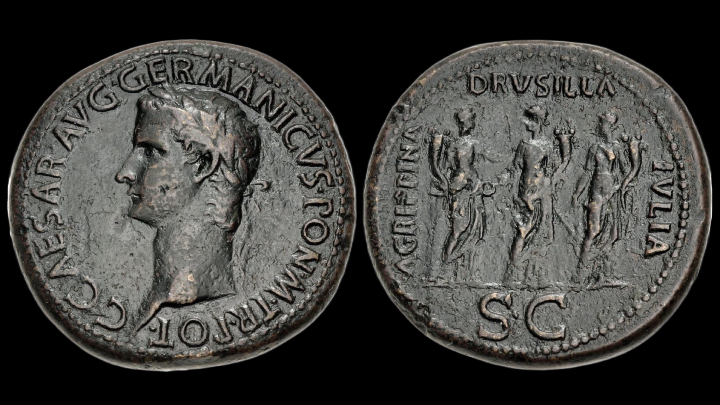In the world of Roman numismatics, some coins do more than reflect an era — they tell its story. The sestertius of Caligula depicting his three sisters — Agrippina, Drusilla, and Julia — is one of the most striking examples of this narrative power.
For the discerning collector, this sestertius is not merely a milestone in imperial history. It is a bronze masterpiece, infused with dynastic ambition, imperial mythology, and personal tragedy. Its artistic composition, unique symbolism, and association with the controversial figure of Caligula make it a cornerstone of any major collection.
A remarkable coin: Caligula and his sisters engraved on the same piece
This bronze sestertius was struck in Rome between AD 37 and 38, at the very beginning of the reign of Gaius Caesar, better known as Caligula — one of the most infamous emperors in Roman history. With a diameter of 35.5 mm and weighing 28.13 grams, this coin belongs to the grand tradition of monumental Roman issues meant for wide circulation throughout the Empire.
The obverse features a laureate portrait of Caligula facing left, surrounded by the inscription: C • CAESAR • AVG • GERMANICVS • PON • M • TR • POT It lists his titles:
It lists his titles: Caesar, Augustus, son of the famous Germanicus, Pontifex Maximus, and holder of tribunician power. The left-facing portrait is unusual, adding to the coin’s uniqueness and visual appeal.
The reverse is without doubt one of the most distinctive in all Roman coinage: it shows Caligula’s three sisters standing side by side, each represented as a Roman deity:
- Agrippina, on the left, as Securitas, holding a cornucopia and leaning on a column
- Drusilla, in the center, as Concordia, holding a patera and a cornucopia, with Agrippina's hand resting on her shoulder
- Julia Livilla, on the right, as Fortuna, holding a rudder and a cornucopia
In the exergue, the letters S C indicate that the coin was struck with the approval of the Senate (Senatus Consulto).
Every detail of this composition delivers a powerful imperial message: the stability of Rome is anchored in the unity of the imperial family.

A Coin at the Heart of Julio-Claudian Power Struggles
The historical importance of this sestertius goes far beyond its numismatic value. It offers a direct glimpse into the early days of Caligula’s reign, at a time when the young emperor was working to sanctify his family and assert his legitimacy.
Shortly after taking power, Caligula enjoyed immense popularity, largely inherited from the glorious memory of his father, Germanicus. By portraying his sisters as divine figures, he was not merely celebrating their virtues — he was incorporating them into the emerging imperial cult. This bold move, politically risky, was both an act of familial devotion and imperial propaganda.
But history would quickly take a darker turn. Drusilla, his favorite sister, died prematurely, plunging Caligula into excessive mourning and leading him to deify her — a highly unusual gesture. As for Agrippina and Julia, they would fall from favor and be exiled a few years later under suspicion of conspiracy. This coin thus becomes a frozen snapshot of a family balance as fragile as it was strategic, immortalized in bronze — and destined to collapse.
A Sestertius Worthy of the Finest Collections
The sestertius of Caligula is a truly exceptional coin. Its rarity, quality, and symbolic weight make it one of the most sought-after sestertii in the entire imperial series.
This particular example, from the prestigious Gilbert Steinberg Collection, was sold for $10,000. It features a rich, even brown patina, with some smoothing in the fields, but retains excellent detail and overall legibility.
If you are looking for this coin, ask us — and we will find it for you.